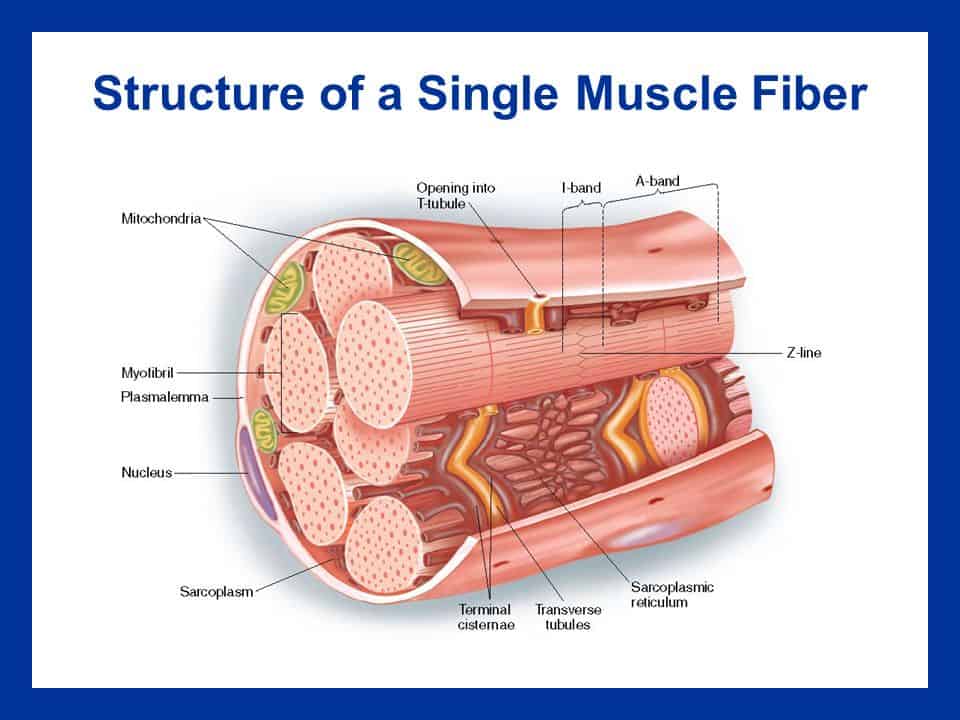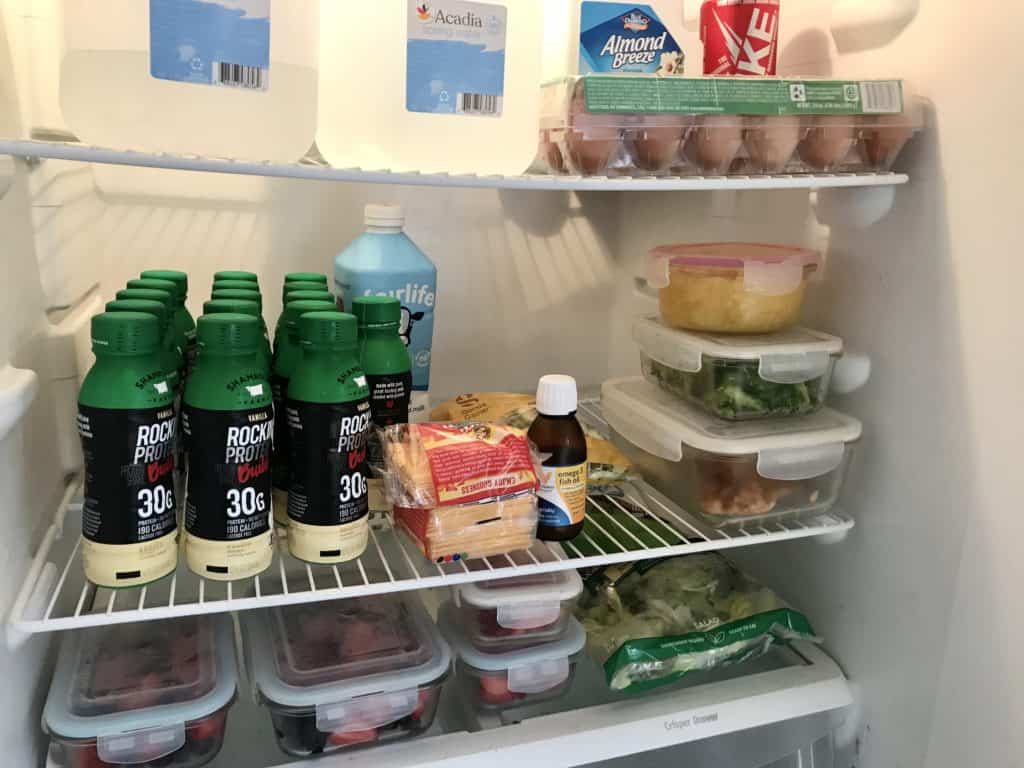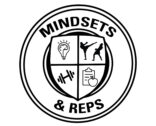
The picture above may rekindle bad memories of a college anatomy class. But it’s remarkable how intricate just one singular muscle cell can be. For the layperson, that diagram is not your entire muscle, that is one tiny muscle fiber which would be barely visible to the naked eye if it was extracted from the body. A muscle, like your bicep, would contain thousands of these muscle fibers.
This article won’t be about the roles of actin and myosin, nor will I explain the sliding filament theory. Quite frankly, you don’t have to know that stuff in order to build muscle. The ironic thing about the diagram above is that despite how complex muscle hypertrophy (muscle growth) can be at the cellular level; the real life application is pretty simple. We know that getting in the gym consistently is a safe bet to put on muscle mass.
But as time goes on sometimes we tend to lose sight of what’s important in favor of techniques that may only make a marginal difference. The muscle growth stops and we can’t figure out why.
Don’t get me wrong, I’m all for trying new techniques and routines. It’s implausible to conceive a time where scientific research shows a one-size-fits-all routine for everybody to maximize muscle growth. Human beings have far too many differences in size, bone structure, and genetics for this to happen.
Regardless of this individual variance, I was able to come up with 10 legitimate reasons that someone may not be building as much muscle as they could be. This comes from personal experience along with training hundreds of clients ranging in all ages and ability levels.
1. Not Consuming Enough Protein
Studies show that people asked to report on their diet will under-report their intake of carbs and fats and over report their intake of protein. Turns out that a bowl of ice cream is four servings instead of one; who knew? This is why it is critical to weigh out your meals on a food scale. When utilizing this practice people soon realize how challenging it can be to consume adequate protein on a daily basis.
The good news is that protein needs to build muscle are not as high as we once thought. The old rule of thumb was one gram per pound of body weight. If you want to follow this practice out of habit, simplicity, or just a liking to high protein foods then that is fine. More protein will not hurt you unless you have some sort of underlying health condition.
Research indicates that 0.8 to 1.0 grams per pound of lean body mass is the number to hit to maximize muscle hypertrophy. Lean body mass is not the same as total body weight. Lean body mass its total weight minus fat mass. Fat mass is calculated by multiplying your percentage body fat by your total weight. If you don’t know this number you can estimate to the best of your ability. An example is outlined below.
180lb male with 10% body fat
180 x .10 = 18lbs of fat mass
180 – 18 = 162lbs of lean body mass
And thus, 162g of protein per day.
162 and 180 may not seem like a tremendous difference, but you can see how an overweight or obese individual would see marked differences in protein intakes using this equation compared to just eating one gram per pound of body weight.
2. Poorly Structured Workouts
Or no structure at all. Beginners can get away with a workout program without structure, since their bodies will respond to almost any stimulus. But as a trainee becomes more advanced, they need to implement periodization in order to continue seeing results.
Periodization simply means strategically planning out a workout program to ensure constant muscle or strength gain. This is typically done in phases. Periodization comes in many forms; and workouts can change on a monthly, weekly, or even daily basis.
Periodization is more about reps and sets rather than the exercises themselves (but those can change as well). Three sets of ten is only going to cut it for so long, yet most people do it for the entirety of their gym career. Going to a phase of heavy weight and lower reps or lighter weight and high reps is an easy way to change a stagnant routine.
3. Not Training Hard Enough
This is a tough pill to swallow for a lot of people. Muscle will not grow unless it has a reason to. Muscle grows as an adaptation to tough workouts. There are no participation trophies for showing up. If you don’t train hard enough, you won’t build muscle.
This complements the notion of periodization quite well. If you’re accustomed to a certain rep range, like sets of ten, then switching to sets of 20 will naturally be more challenging (provided you’re using adequate weight/resistance).
Aside from periodization and workout techniques, over time we tend to lose intensity with our workouts. Getting to the gym is like checking off a box on your to do list. “Yeah, I went to the gym today.” Okay, but did you? Did you really put forth an effort you could be proud of? If someone saw you working out, would they think you train really hard or would they think you were just going through the motions?
Having a good workout isn’t about shouting and throwing weights around, it’s about not cutting corners. It’s about getting depth on your squats even though it hurts and fully extending your arms on a bench press. It’s about setting a goal to do 15 reps and not stopping at 12 when you’re tired.
4. Poor Quality/Not Enough Sleep
Ah yes, the elephant in the room. Sleep is the thing everyone knows is important but is swept under the rug. It’s in the same vein as managing stress. But the old adage is true; it’s while you sleep you grow.
People struggle with poor sleep habits until it becomes a part of their life. They become used to functioning on 4 or 5 hours per night. It shouldn’t be that way though. There are simple tactics to help get to and stay asleep.
One easy fix is to limit blue light usage as bedtime approaches. Blue light is emitted by computers, phones, and televisions. But you don’t have to give these things up completely. Most phones have a option to eliminate the blue light in the phone’s settings. For my laptop I use a program called f.lux (which is free). When you change these settings you’ll notice the screen has an orange hue.
Another tactic you can use is to consume more of your carbohydrates closer to bedtime. Carbohydrates increase serotonin, which is linked with elevated relaxation. Remember that this is not an excuse to eat more carbs; you are simply changing your nutrient timing to reflect this.
Melatonin supplements are hit-or-miss with many people, but overall I can personally say that I have had success with it. Melatonin is a hormone released in the brain that regulates the sleep/wake cycle. The blue light referenced earlier can affect the brain’s ability to produce melatonin. The light is so bright that the brain thinks it’s still daytime. Since melatonin is only about 5 to 10 bucks for bottle, it’s worth a shot. Taking melatonin does not inhibit your body’s ability to produce its own melatonin.

5. Too Few Meals
Old bodybuilding folklore stated that you needed to eat six meals a day to build muscle. Studies have shown that this is not necessary. It’s not bad by any means, but it isn’t necessary.
The response as a result of this new research has gone too far in the opposing direction. People are now implementing diets like OMAD and other forms of extreme fasting with the thought that they can still build maximum amounts of muscle. The way protein synthesis works states otherwise.
When you consume a high protein meal, you experience an elevation in protein synthesis. This is basically the internal process of building muscle. This elevation lasts for a couple hours and is capped at a certain point. As a result, you want as many of these elevations as reasonably possible throughout the day. Perhaps 6 is overkill, but 3 or 4 evenly spaced meals should suffice to maximize muscle growth.
6. Lack of Patience
I always get a chuckle when I hear a sports commentator say something to the effect of: “this athlete put on 15lbs of muscle in the offseason.”
No, no he didn’t. Perhaps he put on 15lbs and a large proportion of it was lean mass, but he certainly did not put on 15lbs of muscle over the summer.
Muscle takes a long time to grow. Your greatest rate of muscle growth will come in the first 1-2 years of training. This is because you are starting from a blank slate and your body is very receptive to growth. After that it becomes much more challenging. It’s the law of diminishing returns.
7. Unreasonable Expectations
The Instagram era has warped our perception of what is an attainable physique. By no means should you ever sell yourself short, but you also shouldn’t compare yourself to a model on the internet that you don’t know personally.
First of all, you have no idea if this individual is using performance enhancing drugs (spoiler alert: there’s a good chance they are). This applies to the women as well. These substances obviously make a tremendous difference and can take a person’s physique beyond what is naturally possible at a physiological level.
Lighting and angles can also turn a person from zero to hero really quickly. I’ll give credit to certain brave individuals that have showcased this. They will show two side-by-side pictures of him or herself, one with perfect lighting and their stomach sucked in and the other just the opposite. There is a stark contrast between the two to say the least.
It’s great to have someone to look up to, but choose wisely. Some people have a goal body they want to achieve but the person has a completely different body type than them. I am 5’10” 185 lbs; average height and my frame is probably a little thicker than the norm. It would make no sense for me to say that I want to achieve a physique like LeBron James. We have two completely different body types.
8. Not Utilizing High Frequency Training
When beginners, particularly men, start a workout program they typically implement split training. Split training means that they work one body part per workout. For example, Monday is a chest day, Tuesday is a back day, etc.
There’s nothing wrong with this type of routine. You can build a lot of muscle with a split routine, but at a certain point it becomes a little redundant. As we mentioned earlier, the muscle needs a reason to grow. Working a muscle once per week, even at a very high intensity, can only do so much after a while.
This is where high-frequency training comes in. This type of training split works muscles two or more times per week. Research suggests that higher frequency training has a more positive impact on muscle growth than singular body part training.
The fear amongst individuals trying a high frequency training routine for the first time is that they won’t be able to get in as much work for each muscle in a workout. But this is kind of the point. No one is expecting you to have the same volume per muscle group per workout. But over the course of a week, since you’re working that muscle group multiple times, you should get as much or more volume in.
Volume, typically measured as reps x sets x weight, or just total number of working sets, is considered the number one factor for building muscle in terms of training. A working set is anything that isn’t a warm-up.
9. Losing Sight of the Basics
As a personal trainer, there was a time where I got a little too fancy with the workouts I would give my clients. My thought process was that I wanted to keep things interesting and not be too repetitive. But in the midst of that I feel that I was doing my clients a disservice so I went back to my old ways. Every now and then I will show them something unique, but 90% of the time I stick with the exercises that work.
When someone is first learning how to lift, a knowledgeable individual or trainer will likely tell them to focus on weight-bearing compound movements. These are things like squats, rows, bench press, and shoulder press among others. In turn, they are taught to avoid machines in favor of these dumbbell and barbell movements.
But then something happens. We naturally begin to stray away from these exercises and move more towards machines and cables. Don’t get it twisted; there is nothing wrong with using machines. But in my opinion the reason people do this is because those basic compound movements are hard. It’s harder to do a bent over barbell row that it is to do a seated cable row. It’s harder to get in the squat rack and load up the bar than it is to do a set of leg extensions.
The reason people are taught to do these compound exercises is because they work. In fact, I’m probably doing them no favor by calling them basic. Basic implies easy or beginner. But they are certainly not easy. If I find myself using too many machines, I make it a point to bring myself over to the dumbbell rack and do my work there.
10. Using the Wrong Supplements
As someone who has dabbled in the supplement industry for a few years, I like to ask people what they use. I get a kick out of people who take testosterone boosters and cortisol blockers, but don’t use something like creatine.
“Creatine? But I don’t want to retain water”
Creatine pulls water into the muscle, not subcutaneously (under the skin). If you experience water retention from supplementing with creatine odds are you need to take a look at your diet. Pulling water into the muscle makes it larger and also more hydrated. In addition, creatine can be used for energy similar to the way we use carbs and fats for energy. Creatine is particularly adept at fueling high intensity activities, such as heavy lifts.
Supplement users can definitely be prone to shiny object syndrome. The ironic thing is that the most proven supplements are generally the most inexpensive. You won’t have to break the bank for creatine, beta alanine, essential amino acids, or even protein powder.
